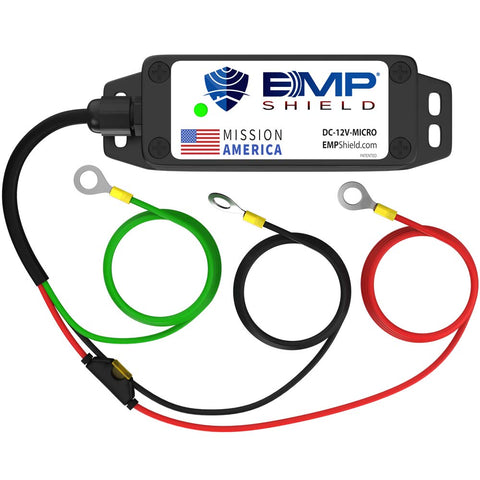
What Is The Best Shielding Against EMP? - The Way to Protect Against Electromagnetic Pulse
What Is The Best Shielding Against EMP?
When it comes to protecting electronic devices from Electromagnetic Pulse (EMP) attacks or solar flares, using the right materials for shielding is crucial. So, just just what is the best shielding against EMP? The best materials for shielding against EMP are those that have high conductivity, high magnetic permeability, and can block or divert electromagnetic radiation effectively.
One of the most effective materials for EMP shielding is copper. Copper has excellent conductivity properties, making it ideal for dissipating electromagnetic fields. Copper can be used in the form of sheets, foils, or even wire meshes to create a shield around electronic devices.
Aluminum is another commonly used material for EMP shielding. While not as conductive as copper, aluminum is more lightweight and can still provide adequate protection against electromagnetic interference. It is often used in combination with other materials for added effectiveness in shielding against EMP pulses.
Steel, particularly mu-metal, is highly effective at shielding against magnetic fields. Mu-metal is an alloy of nickel and iron that has very high magnetic permeability, making it ideal for blocking magnetic radiation from reaching sensitive electronics.
Galvanized steel is also a good choice for EMP shielding due to its affordability and durability. It can be easily formed into different shapes and sizes to create protective enclosures for electronic equipment.
Ferrite is a magnetic material that is commonly used in the form of ferrite beads or ferrite sheets for EMP shielding. Ferrite absorbs and dissipates electromagnetic interference, helping to protect electronic devices from power surges and other harmful effects of EMP.
When it comes to shielding against EMP, using a combination of materials such as copper, aluminum, steel, mu-metal, and ferrite can provide comprehensive protection for electronic devices. It is essential to choose the right materials based on their conductivity and magnetic properties to ensure effective EMP shielding and protect against emp pulses effectively.
Table of Contents
Importance of EMP Protection for Electronic Devices
How to test the effectiveness of EMP shielding
DIY methods for EMP protection
Commercial EMP shielding products and their effectiveness
Importance of EMP protection for electronic devices
Understanding the Significance of EMP Protection for Electronic Devices
In today's interconnected world, electronic devices have become an integral part of our daily lives, aiding us in communication, work, entertainment, and various other essential activities. However, these devices are susceptible to electromagnetic pulses (EMPs) that can arise from natural occurrences like solar flares or human-made incidents such as nuclear detonations. An EMP has the potential to cause significant damage to electronic systems by inducing high currents and voltages that overwhelm delicate circuits, ultimately leading to malfunctions or complete failure.

The Role of EMP Shielding in Safeguarding Electronic Devices
EMP shielding serves as a protective barrier against the harmful effects of electromagnetic pulses. By utilizing materials with high conductivity and magnetic permeability, such as copper, aluminum, or steel, EMP shielding works by redirecting or absorbing the excess energy generated by an EMP, thus preventing it from reaching and damaging the internal components of electronic devices. Properly designed and implemented EMP shielding can significantly increase the survivability of critical electronics during an EMP event.

Types of EMP Shielding Materials
When considering the best materials for EMP shielding, several factors come into play, including conductivity, magnetic permeability, weight, flexibility, and cost. Commonly used materials for EMP shielding include:
-
Copper: Known for its excellent conductivity, copper is a popular choice for EMP shielding applications. Its ability to effectively redirect electromagnetic energy makes it ideal for protecting sensitive electronic equipment.
-
Aluminum: Lightweight and cost-effective, aluminum is another commonly used material for EMP shielding. While not as conductive as copper, aluminum still offers significant protection against EMPs.
-
Steel: With high magnetic permeability, steel is often used in EMP shielding to redirect magnetic fields away from electronic devices, thus providing an additional layer of protection.

Choosing the right material for EMP shielding depends on the specific requirements of the electronic devices being protected and the level of protection needed.
Implementing Effective EMP Protection Strategies
EMP protection measures into the design and operation of critical electronic systems is essential to ensure their resilience against EMP events. Some key strategies for effective EMP protection include:
-
Hardening electronic devices: Designing electronic systems with built-in shielding and surge protection mechanisms can help mitigate the impact of EMPs.
-
Grounding: Proper grounding of electronic equipment can dissipate excess energy and minimize the risk of damage during an EMP event.
-
Enclosure shielding: Enclosing electronic devices in shielded containers or Faraday cages can provide an additional layer of protection against electromagnetic interference.
By integrating these strategies and utilizing the right materials for EMP shielding, individuals and organizations can enhance the survivability of their electronic devices in the face of potential EMP threats.
How to test the effectiveness of EMP shielding
When it comes to protecting electronic devices from Electromagnetic Pulse (EMP) attacks or natural occurrences such as solar flares, testing the effectiveness of EMP shielding is crucial. There are several methods to ensure that the shielding in place will adequately protect the sensitive electronics.
One common way to test EMP shielding effectiveness is through the use of EMP simulators. These simulators are designed to replicate the effects of an actual EMP event in a controlled environment. By subjecting the shielded electronic devices to the simulated EMP, testers can gauge how well the shielding performs under such conditions.
Another method involves using an electromagnetic pulse generator to emit high-intensity electromagnetic fields. By measuring the amount of electromagnetic energy that penetrates the shielded enclosure, testers can determine the level of protection offered by the shielding material.
Furthermore, conducting a transient surge test can also assess the effectiveness of EMP shielding. This test involves exposing the shielded electronics to high-voltage surges to mimic the effects of an EMP. By analyzing how well the shielding mitigates the impact of these surges, testers can evaluate its protective capabilities.
It is important to note that testing the effectiveness of EMP shielding should be done by professionals with the necessary expertise in electromagnetic compatibility testing. This ensures accurate results and provides confidence in the shielding's ability to safeguard electronic devices against EMP threats.
Regular testing and maintenance of EMP shielding are essential to ensure continued protection of critical infrastructure and electronic equipment, ultimately helping to protect your electronics from EMP damage. By following proper testing procedures, businesses and individuals can have peace of mind knowing that their devices are shielded against potential EMP dangers.
DIY methods for EMP protection
When it comes to protecting electronic devices from the detrimental effects of electromagnetic pulses (EMPs), it is essential to consider do-it-yourself (DIY) methods for shielding against EMP. While there are commercial EMP shielding products available in the market, these can sometimes be costly or difficult to procure. Therefore, exploring DIY EMP protection methods can be a practical and cost-effective alternative for individuals looking to safeguard their electronic equipment.

Understanding DIY EMP Protection
DIY EMP protection involves using readily available materials to shield electronic devices from the impact of electromagnetic pulses. One common approach to DIY EMP shielding is creating a Faraday cage. A Faraday cage is an enclosure made of conductive materials that can block electromagnetic fields, including those from EMP sources, acting as an effective way to protect against EMP damage. By constructing a Faraday cage around electronic devices, individuals can prevent EMPs from damaging sensitive components.
Materials for DIY EMP Shielding
Several materials can be used for constructing a DIY Faraday cage for EMP protection, a practical approach to prevent electromagnetic interference and safeguard your electronics. Commonly used materials include copper, aluminum, galvanized steel, and conductive fabrics. These materials are effective at blocking electromagnetic radiation and can be shaped into enclosures that fit various electronic devices. Ensuring that the Faraday cage is properly sealed and free from any gaps is crucial to its effectiveness in shielding against EMP.
Benefits of DIY EMP Protection
One of the primary advantages of DIY EMP protection is the ability to customize the shielding solution according to specific needs. By opting for a DIY approach, individuals can tailor the design and size of the Faraday cage to accommodate different electronic devices. Additionally, DIY EMP protection allows for greater flexibility in terms of cost and accessibility, as materials for constructing a Faraday cage can be easily sourced from hardware stores or online retailers.
Considerations for Effective EMP Shielding
While DIY EMP protection can be an excellent option for safeguarding electronic devices, it is essential to ensure that the shielding is properly implemented. Testing the effectiveness of the Faraday cage using an EMP simulator or meter can help verify its ability to block electromagnetic pulses. Furthermore, regular maintenance and inspection of the shielding materials are recommended to address any potential wear or damage that could compromise the protection against EMP events.
DIY methods for EMP protection offer a practical and budget-friendly solution for enhancing the resilience of electronic devices against electromagnetic pulses. By leveraging readily available materials and constructing a custom Faraday cage, individuals can significantly reduce the risk of damage caused by EMPs and prolong the lifespan of their valuable electronics.
Commercial EMP shielding products and their effectiveness
Understanding Commercial EMP Shielding Products
When it comes to safeguarding electronic devices from Electromagnetic Pulse (EMP) attacks, utilizing commercial EMP shielding products can be a significant defense strategy. These products are specifically designed to protect against the damaging effects of EMPs, which can result from natural phenomena like solar flares or human-made sources such as nuclear blasts.
One popular type of commercial EMP shielding product is the Faraday cage. This enclosure is constructed using conductive materials like copper or aluminum, which helps to create a barrier that blocks out EMP waves from penetrating and impacting the electronic devices housed inside. Faraday cages are highly effective in mitigating EMP risks and are commonly used in industries where continuous operation of electronic systems is critical.
Another effective commercial EMP shielding product is the EMP shielding pouch. These pouches are made from multiple layers of metallic materials that can effectively block out EMP radiation. Electronic devices such as smartphones, tablets, or laptops can be stored in these pouches to prevent any potential damage caused by EMP exposure.
For larger electronic systems or infrastructure, EMP shielding rooms or tents are available in the market. These enclosures are designed to provide a secure space for critical electronic equipment to operate without being affected by EMP events. EMP shielding rooms are constructed using specialized materials that offer a high level of protection against EMP waves.
I would be amiss if I didn't mention the EMP Shield. This highly popular product can protect your home, vehicle, generator, etc. from the electrical surge caused by an EMP event. At the time of writing this the EMP Shield is so in demand that the company is currently on backorder by 1 to 2 weeks. I guess you could infer something from this. If you want to get one of your own please check them out at the link below.
It is essential to note that not all commercial EMP shielding products are created equal. Before investing in any EMP shielding product, it is crucial to research and ensure that the product has been tested and certified to meet industry standards for EMP protection. Additionally, considering factors such as the specific requirements of the electronic devices, the level of protection needed, and budget constraints can help in selecting the most suitable commercial EMP shielding product for a particular application.
Choosing the right commercial EMP shielding product is a proactive step towards safeguarding electronic devices from the potentially devastating effects of EMP attacks. By investing in reliable and tested shielding products, individuals and organizations can enhance the resilience of their electronic systems and minimize the risks associated with EMP exposure.
Key Takeaway:
Understanding the best materials for shielding against Electromagnetic Pulse (EMP) is crucial for effectively protecting electronic devices. EMP protection is vital as it can safeguard critical equipment from potential damage caused by electromagnetic interference. Testing the effectiveness of EMP shielding ensures that the protective measures are reliable and secure. For those interested in do-it-yourself (DIY) methods for EMP protection, there are various techniques and materials available to enhance safeguarding electronic devices. Additionally, considering commercial EMP shielding products can provide advanced protection with proven effectiveness, offering peace of mind for individuals and organizations seeking comprehensive protection against EMP threats. By implementing appropriate EMP shielding measures, it is possible to mitigate risks and safeguard electronic equipment from the detrimental effects of electromagnetic pulses.
Conclusion
Protecting electronic devices against electromagnetic pulse (EMP) is crucial in today's technologically advanced world. Various materials such as copper, aluminum, and conductive fabrics have proven to be effective in shielding against EMP. These materials help in creating a Faraday cage that can block or divert the harmful effects of electromagnetic pulses.
It is essential to safeguard devices against EMP as they are susceptible to damage or malfunction when exposed to high-intensity electromagnetic fields. By investing in EMP protection, individuals and organizations can prevent data loss, equipment failure, and potential security breaches caused by EMP attacks or natural occurrences like solar flares.
Testing the effectiveness of EMP shielding is a critical step in ensuring the safety of electronic devices. Various methods such as using an EMP simulator or hiring professionals to conduct testing can help determine if the shielding is robust enough to withstand EMP threats.
For those looking for do-it-yourself (DIY) solutions for EMP protection, there are simple yet effective methods available. Building a Faraday cage using materials like aluminum foil or metal trash cans can provide basic protection for smaller devices such as smartphones or radios.
Alternatively, there are commercial EMP shielding products that offer advanced protection for a wide range of electronics. These products, such as EMP bags, shielded enclosures, and surge protectors, are designed to meet specific EMP protection standards and are tested for their effectiveness in blocking electromagnetic pulses.
Safeguarding electronic devices against EMP is a crucial consideration for individuals, businesses, and governments alike. By utilizing the best materials for EMP shielding, understanding the importance of EMP protection, testing the effectiveness of shielding methods, exploring DIY solutions, and considering commercial EMP shielding products, one can mitigate the risks associated with EMP exposure and ensure the longevity and functionality of their electronic devices.
🔗 Related: Alternative Power products
🔗 Related: Shop alternative power




Comments
Leave a comment